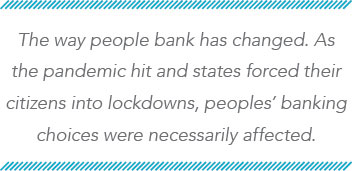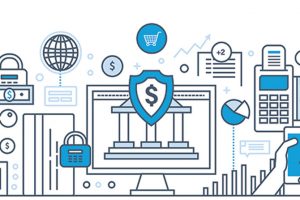By Nicholas P. Mooney II and Angela L. Beblo, Spilman Thomas & Battle
The COVID-19 pandemic has touched virtually every facet of life. It isn’t surprising that it also has changed the way banks deliver financial services to their customers. Below are six ways the pandemic is reshaping banking.
1. Forbearance and related debt relief. The CARES Act, passed in March 2020, provided protections to borrowers with federally backed mortgages. Those include mortgages held or backed by the Federal Housing Administration, the United States Department of Veterans Affairs, the United States Department of Agriculture, the Federal National Mortgage Association (also known as Fannie Mae), and the Federal Home Loan Mortgage Corporation (commonly known as Freddie Mac). There are two important aspects of the CARES Act with respect to mortgages:
First, servicers and lenders are prohibited from foreclosing from March 18, 2020, until Dec. 31, 2020. This includes both judicial and non-judicial foreclosures. Further, it includes any foreclosure in process on March 18, 2020, as lenders and servicers are prohibited from finalizing any foreclosure judgment or sale. This is a mandatory provision, and there are no steps a homeowner must take to obtain this relief.
2. Second, homeowners may affirmatively request forbearances for their loans. If a homeowner is experiencing financial hardship due to COVID, the homeowner may request a forbearance for up to 180 days. Also, a homeowner may request a second forbearance of up to 180 additional days. Thus, in total, a homeowner may request a forbearance for up to 360 days. The burden is on the homeowner to make the request to the servicer or lender. If a homeowner requests a CARES Act forbearance, there “will be no additional fees, penalties or additional interest (beyond scheduled amounts) added to” the loan. Homeowners are not required to submit documentation to prove a COVID-related hardship other than the initial claim that financial hardship is related to COVID. There is a Dec. 31, 2020, deadline for the initial request to be made for some of the federally backed mortgages.
The way people bank has changed. As the pandemic hit and states forced their citizens into lockdowns, peoples’ banking choices were necessarily affected. For many, the ability to visit a physical branch was greatly curtailed, if not altogether prohibited. As a result, they turned to their banks’ digital offerings. One commentator reported a 200% jump in new mobile banking registrations in the early days of the pandemic, coinciding with an estimated 50% drop in branch traffic during the same period. While millennials traditionally have led the charge on digital banking, older generations aren’t being left behind. Indeed, according to Donna Turner, COO of Early Warning, which operates the popular Zelle peer-to-peer payment app, since the onset of the pandemic, baby boomers have “been the faster-growing demographic.”

3. “The end of cash has never been closer.” As reported by a recent EY Future Consumer Index, the use of cash has been on the decline, but the onset of the pandemic has quickened it. Consumers have a concern over whether handling physical cash can spread the coronavirus. That concern has translated into a sizable drop in cash usage. Further, EY reports that this drop may not be temporary. Of those who responded to the EY survey, at least 20% expect to continue using less cash for the foreseeable future. This drop will likely be attributed to the rise in mobile and contactless payments, which we discuss next.
4. The rise of contactless payments. Before the pandemic, contactless and mobile payments were already on the rise. The onset of the pandemic accelerated their adoption. VISA’s Back to Business Survey, a global survey of small businesses and consumers, demonstrates how customers’ payment habits have changed due to the pandemic. The survey reported that 78% of consumers changed how they pay for an item to reduce contact. Nearly half of consumers (46%) responded that contactless payment methods are among the most critical safety measures they look for when deciding how to shop and what payment methods to use. About the same amount (48%) would not shop at a store that only offers payment methods that require contact with a cashier or shared device.
5. Remote online notarization and digital mortgages. Digital mortgage originations and closings were already in the works before the pandemic hit. The move toward digitizing the mortgage process started years ago as states began passing laws permitting remote online notarization (RON). The passage of those laws gained steam last year, while lenders also began investing in technology to compete with those already in the digital mortgage space. The pandemic has prompted states to accelerate their adoption of RON laws. However, there still are hurdles to overcome before completely digital mortgage originations and closings can be a standard in the industry. RON laws vary from state to state, and some are temporary legislation meant only to bridge the gap during the pandemic.
6. Changes in attitude toward debt. The pandemic has forced consumers to consider financial basics like how they handle debt. Although consumers still use credit cards, their uncertainty about potential job loss or pay cuts has caused them to use those cards differently. According to the Federal Reserve’s Survey of Consumer Finances, in 2019, 45% of American families had outstanding credit card debt. Since the pandemic onset, consumers have focused on shedding as much of that debt as possible. At the start of 2020, Americans owed approximately $1.09 trillion in credit card debt. By July 2020, that amount was down to $99.5 billion as consumers reduced discretionary spending and used part or all stimulus checks to reduce credit card debt.
Nick Mooney and Ang Beblo serve as co-editors of Spilman’s financial litigation-focused e-newsletter, All Consuming.

Nick’s primary area of practice is consumer financial services litigation in federal and state courts. He also co-chairs the firm’s technology law practice group and serves as co-editor of the firm’s technology law-focused e-newsletter, Decoded. He can be reached at 304.340.3860 or nmooney@spilmanlaw.com.

Ang’s primary areas of practice are consumer finance and litigation. She is counsel in the firm’s Charleston, West Virginia office. She can be reached at 304.340.3852 or abeblo@spilmanlaw.com.
This story appears in Issue 4 2020 of the West Virginia Banker Magazine.









